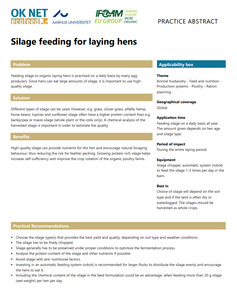{Tool} Silage feeding for laying hens (OK-Net Ecofeed Practice Abstract). Creator(s): Steenfeldt, S.. Issuing Organisation(s): AU - Aarhus University. OK-Net EcoFeed practice abstract. (2019)
|
PDF
- Published Version
- English
(Practice abstract)
494kB | |
![[thumbnail of 2023-09-27 11_48_08-PA_00035470_L0.pdf.png]](/35470/5.hassmallThumbnailVersion/2023-09-27%2011_48_08-PA_00035470_L0.pdf.png)  Preview |
Image (PNG)
- Cover Image
- English
101kB |
Document available online at: https://orgprints.org/35470/
Summary in the original language of the document
High-quality silage can provide nutrients for the hen and encourage natural foraging behaviour, thus reducing the risk for feather pecking. Growing protein-rich silage helps increase self-sufficiency and improve the crop rotation of the organic poultry farms.
Practical recommendation
• Choose the silage type(s) that provides the best yield and quality, depending on soil type and weather conditions.
• The silage has to be finely chopped.
• Silage generally has to be preserved under proper conditions to optimize the fermentation process.
• Analyse the protein content of the silage and other nutrients if possible.
• Avoid silage with anti-nutritional factors.
• Investing in an automatic feeding system (robot) is recommended for larger flocks to distribute the silage evenly and encourage the hens to eat it.
• Including the chemical content of the silage in the feed formulation could be an advantage, when feeding higher amounts per hen per day (>20 g per day).
| EPrint Type: | Practice tool |
|---|---|
| What problem does the tool address?: | Feeding silage to organic laying hens is practised on a daily basis by many egg producers. Since hens can eat large amounts of silage, it is important to use high-quality silage. |
| What solution does the tool offer?: | Different types of silage can be used. However, e.g. grass, clover grass, alfalfa, hemp, horse beans, lupines and sunflower silage often have a higher protein content than e.g. barley/pea or maize silage (whole plant or the cobs only). A chemical analysis of the harvested silage is important in order to estimate the quality. |
| Country: | Denmark |
| Type of Practice Tool: | Practice abstracts |
| Keywords: | animal husbandry, feeding, rations, layer chickens |
| Agrovoc keywords: | Language Value URI English layer chickens http://aims.fao.org/aos/agrovoc/c_12109 English feeding http://aims.fao.org/aos/agrovoc/c_2838 English rations http://aims.fao.org/aos/agrovoc/c_6461 English animal husbandry http://aims.fao.org/aos/agrovoc/c_8532 |
| Subjects: | Animal husbandry > Feeding and growth Animal husbandry > Production systems > Poultry |
| Research affiliation: | European Union > Horizon 2020 > OK-Net EcoFeed European Union > Horizon 2020 > OK-Net EcoFeed > OK-Net Ecofeed Tools Denmark > AU - Aarhus University > Faculty of Science and Technology > Department of Animal Science International Organizations > International Federation of Organic Agriculture Movements IFOAM > IFOAM Organics Europe European Union > Organic Farm Knowledge |
| Horizon Europe or H2020 Grant Agreement Number: | 773911 |
| Related Links: | https://organic-farmknowledge.org/tool/35470, https://www.facebook.com/organicfarmknowledge/photos/a.341364110046066/536536380528837, https://twitter.com/farm_knowledge/status/1194975581760344067 |
| Project ID: | ofk |
| Deposited By: | Willer, Dr. Helga |
| ID Code: | 35470 |
| Deposited On: | 12 Nov 2019 10:17 |
| Last Modified: | 02 May 2024 10:32 |
| Document Language: | English |
| Status: | Published |
Repository Staff Only: item control page

 Download Statistics
Download Statistics Download Statistics
Download Statistics
